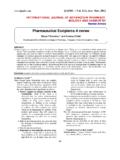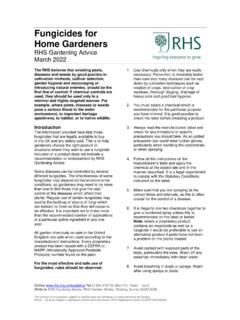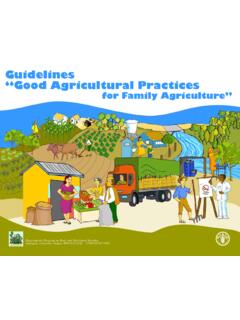Transcription of Biopestcides: Types and Applications
1 IJAPBC Vol. 1(4), Oct- Dec, 2012 ISSN: 2277 - 4688. _____. INTERNATIONAL JOURNAL OF ADVANCES IN. PHARMACY, BIOLOGY AND CHEMISTRY. Review Article Biopestcides: Types and Applications Shilpi Sharma and Promila Malik Post Graduate Govt College, Sector-11, Chandigarh, India. ABSTRACT. Food losses in the world are high. The main aspect of this problem is the due to damage of crops that leads to loss of production and this also affects the health of ,pestcides are developed to control this but they have created serious ecological problems. Biopesticides are very effective in the agricultural pest control without causing serious harm to ecological chain or worsening environmental paper presents the need of biopestides ,its different Types and it Applications .
2 Keywords: Biopesticides ,Integreated Pest Management , Microbial Biopestcides. INTRODUCTION mushrooms and control of these has become In recent years, few environmental issues have necessary to reduce failures to a minimum. aroused the concern of the public as much as 'Biopesticides' are certain Types of pesticides pesticides, especially in relation to the health of derived from such natural materials as animals, children. In spite of the many published studies on plants , bacteria, and certain minerals. These include the subject of pesticides and human health, there for example; fungi such as Beauveria sp., bacteria remains deep controversy surrounding this such as Bacillus sp.
3 , neem extract and pheromones. are in a dilemma to either sacrifice a Similarly Canola oil and baking soda have significant share of their crops to pests or use pesticide Applications and are considered as highly toxic pesticides that can harm human health biopesticides. The use of these materials is and the are key widespread with Applications to goliage, turf, soil, elements of incorporated insect management (IPM) or other environments of the target insect pests. In programs, and are receiving much practical a much simpler way we can say that these are pest attention as a means to reduce the fill of artificial management tools that are based on beneficial chemicals being used.
4 Heavy use of synthetic microorganisms (bacteria,viruses, fungi and chemicals for pest control started from 1940s. Till protozoa), beneficial nematodes or other safe, then we were using natural insecticides namely biologically based active ingredients. Benefits of rotenone from the roots of derris plant, and biopesticides include effective control of insects, pyrethrum from the flower heads of a species of plant diseases and weeds, as well as human and twenty years it was found environmental safety. Biopesticides also play an that the level of synthetic pesticides were building important role in providing pest management tools and were not biodegradable and their harmful in areas where pesticide resistance, niche markets effects started coming out.
5 There is a need to create and environmental concerns limit the use of biopesticides which are effective, eco-friendly and chemical pesticide products. The most widely do not leave any harmful effect on environment. known microbial pesticides are varieties of the Gardening is the back-bone of Native Indian bacterium Bacillus thuringiensis, or Bt, which can economic climate. Up to 70% of the inhabitants is control certain insects in cabbage, potato, and other involved in town industry straight or in a crops. Bt produces a protein that is harmful to roundabout way. Growing Native Indian specific insect pest. Certain other microbial inhabitants needs sufficient town produce.
6 Pesticides act by out-competing pest organisms. Gardening and the agriculture vegetation are Microbial pesticides need to be continuously vulnerable to problems by various kinds of monitored to ensure that they do not become unwanted pest infestations in form of bugs, capable of harming non-target organisms, including infection, harmful bacteria or virus or fresh humans. 508. IJAPBC Vol. 1(4), Oct- Dec, 2012 ISSN: 2277 - 4688. _____. Some success stories about successful utilization of continuously monitored to ensure that they do not biopesticides and bio- control agents in Indian become capable of harming non-target organisms, agriculture include1 including humans.
7 Organisms. Bt can be applied to 1. control of diamondback moths by plant foliage or incorporated into the genetic Bacillus thuringiensis, material of crops and as discovered, it is toxic to 2. control of mango hoppers and mealy bugs the caterpillars (larvae) of moths and butterflies. and coffee pod borer by Beauveria, These also can be used in controlling mosquitoes 3. control of Helicoverpa on cotton, pigeon- and black flies. Several strains of Bt have been pea, and tomato by Bacillus thuringiensis, developed and now strains are available that 4. control of white fly on cotton by neem control fly larvae. While some Bt's control moth products, larvae found on plants , other Bt's are specific for 5.
8 control of Helicoverpa on gram by larvae of flies and mosquitoes. The target insect , species are determined by whether the particular Bt 6. control of sugarcane borers by produces a protein that can bind to a larval gut Trichogramma and receptor, thereby causing the insect larvae to starve. 7. control of rots and wilts in various crops by Trichoderma-based products. B. Plant- Incorporated-Protectants(PIPs). PIPs are pesticidal substances that plants produce Table 1: Biopesticides Registered from genetic material that has been added to the under Insecticides Act,19682 plant. For example, scientists can take the gene for Name of the Biopesticides the Bt pesticidal protein, and introduce the gene 1 Bacillus thuringiensis var.
9 Israelensis into the plants own genetic material. Then the 2 Bacillus thuringiensis var. kurstaki plant, instead of the Bt bacterium manufactures the 3 Bacillus thuringiensis var. galleriae 4 Bacillus sphaericus substance that destroys the pest. Both the protein 5 Bacillus sphaericus and its genetic material are regulated by EPA; the 6 Bacillus sphaericus plant itself is not regulated. 7 Pseudomonas fluoresens 8 Beauveria bassiana C. Biochemical pesticides 9 NPV of Helicoverpa armigera 10 NPV of Spodoptera litura These are naturally occurring substances such as 11 Neem based pesticides plant extracts, fatty acids or pheromones that 12 Cymbopogan control pests by non-toxic mechanisms.
10 Conventional pesticides, by contrast, are synthetic Types of Biopesticides materials that usually kill or inactivate the pest. Biopesticides fall into three major categories1 Biochemical pesticides include substances that interfere with growth or mating, such as plant A. Microbial pesticides growth regulators, or substances that repel or Microbial biopesticides represent an important op- attract pests, such as pheromones. Because it is tion for the management of plant diseases. The sometimes difficult to determine whether a natural United States Environmental Protection Agency pesticide controls the pest by a non-toxic mode of (EPA) defines biopesticides as, certain Types of action, EPA has established a committee to pesticides derived from such natural materials as determine whether a pesticide meets the criteria for animals, plants , bacteria, and certain minerals.









